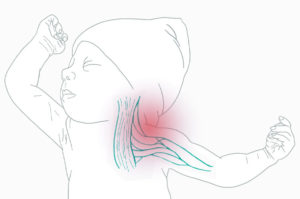What is Erb’s palsy?
 Erb’s palsy — or Erb-Duchenne palsy — is a nerve condition that causes muscle weakness in the shoulder and arm.
Erb’s palsy — or Erb-Duchenne palsy — is a nerve condition that causes muscle weakness in the shoulder and arm.
Also called brachial plexus palsy, the condition affects the brachial plexus, a group of nerves that connects the spine to the arm and hand, allowing the shoulders, arms, and hands to move. This type of nerve injury may also affect shoulder growth or development.
There are four main types of Erb's palsy nerve damage:
- Avulsion: This is the most serious type because the nerve rips away from the spine.
- Neuroma: This is when the nerve was torn and healed but has left scar tissue that interferes with sending signals to the muscles.
- Neuropraxia: This is the most common type, and it happens when the nerve is stretched but does not tear.
- Rupture: This type involves the nerve getting torn but not ripped from the spine.
To learn more about Erb’s palsy, its causes, and available treatment options, download our Free Erb's Palsy Guide.
What causes Erb’s palsy in newborns?
Erb’s palsy in newborns is caused by a birth injury, usually during a difficult delivery. Erb’s palsy causes can occur during both vaginal childbirth and C-section (cesarean section) deliveries.
Often, what causes Erb's palsy is a health care provider pulling a baby's head during the birthing process. Sometimes, this stretching can cause nerve damage or even nerve tears.
Other Erb's palsy causes may include using extra force to get a baby out of the birth canal during a difficult delivery or when a baby is in an awkward position in the womb.
Almost 12,000 Erb's palsy cases are diagnosed each year. The most common cause is larger babies getting stuck during delivery and having to be pulled out.
In many cases, Erb's palsy causes could not have been avoided. However, there are some instances in which health care providers could have prevented the physical injury to the baby’s brachial plexus that caused Erb’s palsy.
Of all causes of Erb’s palsy, shoulder dystocia is the most common. In fact, the risk of Erb’s palsy is nearly three times as high when shoulder dystocia occurs.
What is shoulder dystocia?
Shoulder dystocia is a specific type of birth injury that occurs when one or both of a baby’s shoulders become stuck in the birth canal during vaginal delivery. Common causes of shoulder dystocia include the mother having a small pelvis or the baby being large or awkwardly positioned.
Shoulder dystocia occurs in 5-9% of babies weighing more than 8 pounds, 13 ounces.
Unfortunately, there are no warning signs that shoulder dystocia may occur. There is also no way to prevent the condition from happening. However, there are certain risk factors to be aware of so you are prepared.
Risk factors for shoulder dystocia include:
- Being pregnant with more than one baby
- High infant birth weight
- Labor and delivery medications, such as oxytocin (Pitocin®) or anesthesia administered through an epidural
- Maternal diabetes (diagnosed before or during pregnancy)
- Maternal obesity
Additionally, the risk of shoulder dystocia increases by 15% for mothers who have already had a baby with shoulder dystocia.
Shoulder dystocia can cause severe complications and is considered a medical emergency.
Shoulder dystocia long-term effects
Erb’s palsy is one of the most common complications of shoulder dystocia. The condition can also cause a fracture to the newborn’s clavicle (collarbone) and/or upper arm bone.
Because of increased neck pressure, shoulder dystocia can block blood flow and oxygen transfer.
In some cases, shoulder dystocia can cause the umbilical cord to become trapped between the baby’s arm and the mother’s pelvic bone, cutting off the baby’s blood flow and oxygen. While this is very rare, shoulder dystocia can result in brain damage or infant death.
According to Cleveland Clinic, 50% of babies born with shoulder dystocia regain normal functioning. By 18 months, this number increases to 80%.
The long-term effects of shoulder dystocia may include difficulty using the affected limb and trouble with fine motor skills. Sadly, nearly 10% of shoulder dystocia cases result in permanent injury.
For more information and helpful resources, download our Free Erb’s Palsy Guide.
What are the risk factors of Erb's palsy?
Erb’s palsy is often unavoidable due to circumstances beyond the control of expectant mothers and health care providers. However, knowing the risk factors of Erb’s palsy can help families better advocate for themselves and their children.
Erb’s palsy risk factors include:
- Breech birth (baby is born feet-first)
- Complications from forceps, vacuum extractors, or other assistive delivery devices
- Failure to order a C-section when a baby’s size makes vaginal birth too risky
- Improper delivery, such as quick or forceful pulling
- Large infant size or high birth weight
- Maternal diabetes (diagnosed before or during pregnancy)
- Maternal obesity or high weight gain during pregnancy
- Second stage of labor (pushing) lasting over an hour
- Small or abnormally shaped maternal pelvis
Tragically, medical negligence can come into play in any of these situations. Doctors and nurses are trained to deal safely with complicated deliveries. However, Erb’s palsy causes are sometimes mistakes made by medical professionals.
For example, the delivering doctor may cause the nerve injury that leads to Erb’s palsy by forcefully pulling the baby’s head or neck sideways through the birth canal. In other cases, they might have failed to order a cesarean section, which could have prevented the baby’s nerve damage in the first place.
What muscles are damaged in Erb's palsy?
The nerves in the arms, shoulders, and hands are damaged, which in turn prevents babies from fully using the muscles in these body parts.
 Erb’s palsy is sometimes referred to as brachial plexus birth palsy. This comes from the name of the network of nerves affected by the condition. The brachial plexus sends signals from the spinal cord to the shoulders, arms, and hands.
Erb’s palsy is sometimes referred to as brachial plexus birth palsy. This comes from the name of the network of nerves affected by the condition. The brachial plexus sends signals from the spinal cord to the shoulders, arms, and hands.
Brachial plexus injury occurs when these nerves are stretched, compressed, or torn away from the spinal cord. This type of injury is what causes Erb's palsy.
Erb’s palsy nerve damage occurs in the upper nerves, which affects the arm muscles, including the deltoid, biceps, brachialis, and rhomboids.
Because of the muscles that are impacted by nerve damage, Erb’s palsy restricts movement at the baby’s shoulder and elbow joints.
Erb's palsy symptoms
The symptoms of Erb’s palsy in newborns may not be immediately noticeable. Therefore, it is very important to closely monitor your baby after birth, especially if any of the common causes of Erb’s palsy occurred during delivery.
Erb’s palsy symptoms include:
- Dangling arm with fingers curved upwards (waiter’s tip)
- Limp arm
- Muscle weakness
- Numbness
- Partial or complete paralysis of the arm
- Reduced ability to grip
If you notice any worrisome symptoms in your baby, contact your pediatrician. Early diagnosis and treatment are the best ways to ensure your child makes a quick and complete recovery.
Unsure whether your baby is showing signs of Erb’s palsy? Chat with one of our registered nurses now.
How is Erb’s palsy diagnosed?
Pediatricians usually diagnose Erb's palsy in newborns. It is crucial to watch for symptoms and call your baby's doctor right away if you notice potential warning signs. This is especially true if you had a complicated delivery or experienced other common causes of Erb's palsy.
Your child’s pediatrician will first do a physical examination to look for weakness or range-of-motion issues in the upper arm. If Erb’s palsy is suspected, they may order imaging tests.
Diagnosing Erb’s palsy may involve the following scans:
- Computed tomography (CT) myelography: This test combines a contrast dye with a series of X-ray images to look for possible Erb’s palsy causes (issues in the spinal cord, nerve roots, and tissues).
- Electromyogram (EMG): This is a low-risk procedure that inserts a needle electrode into a muscle to assess its health by recording electrical activity.
- Magnetic resonance imaging (MRI): This non-invasive imaging technique uses magnetic scanners to produce 3D images to look for issues.
- Nerve conduction study (NCS): This is a diagnostic test that evaluates nerve function by stimulating nerves with electrode patches that attach to the skin.
- Ultrasound: This test involves sending out a beam of sound waves to take pictures inside of the body.
- X-ray: This is an imaging study that uses invisible electromagnetic beams to take pictures of bones and soft tissues.
These tests can help determine if there is bone or joint damage in your baby’s neck and shoulder.
Can Erb's palsy be cured?
Yes, in most cases, babies with Erb’s palsy usually make a complete recovery, regaining strength and movement in the affected arm. In some cases, the condition even resolves on its own in 3-4 months.
However, some Erb’s palsy cases require more intensive treatment and can leave babies with long-term or permanent disabilities.
“In some children, the affected arm is noticeably smaller than the unaffected arm. This occurs because nerves do have an effect on growth.”
—American Academy of Orthopaedic Surgeons
Getting an early diagnosis and treatment is extremely important to ensure the best possible outcome. When treatment is neglected, up to 30% of Erb’s palsy cases can lead to permanent nerve damage.
Long-term complications of Erb’s palsy include:
- Abnormal joint function
- Decreased strength and stamina
- Different length arms
- Impaired bone growth
- Muscle weakness
- Osteoarthritis
- Poor balance and coordination
To reduce the risk of long-term effects of Erb’s palsy, getting the best treatment for your baby is critical. Complications from untreated Erb’s palsy can lead to unforeseen issues for years to come.
Erb's palsy treatment in newborn babies
Seeking prompt Erb’s palsy treatment is the best way to increase your baby’s chances of making a full recovery. If a baby with Erb’s palsy doesn’t recover or undergo corrective surgery, they will likely have arm and shoulder problems later in life.
“The longer a nerve injury remains untreated, the more difficult it may be to achieve an optimal outcome.”
—Cleveland Clinic
Treatment for Erb's palsy depends on how severe the injury is. Your baby's pediatrician will likely recommend physical therapy and home exercises starting at three weeks old.
Non-surgical treatment for Erb’s palsy may include:
- Botulinum toxin (Botox®) injections to relieve contractures (excessive shortening of the muscles)
- Erb's palsy physiotherapy treatment
- Hydrotherapy combining exercise and water
- Occupational therapy
- Range-of-motion exercises and stretching
If non-surgical brachial plexus palsy treatment is not successful after your baby is six months of age, your doctor may recommend surgery. This could include nerve graft surgery, nerve transfers, tendon transfers, or muscle repair surgery.
Since nerves are slow to recover, it may take months or years for the muscles in the lower arm and hand to function correctly. During this time, caregivers must perform at-home exercises to improve the strength of the baby’s arm.
 Seeking treatment for a child’s Erb’s palsy is an unexpected complication that can be difficult for new parents to face. This is why getting an early diagnosis is especially important. With proper and prompt treatment, Erb’s palsy is more likely to resolve.
Seeking treatment for a child’s Erb’s palsy is an unexpected complication that can be difficult for new parents to face. This is why getting an early diagnosis is especially important. With proper and prompt treatment, Erb’s palsy is more likely to resolve.
Get help finding treatment for Erb’s palsy by contacting our team of registered nurses at (855) 220-1101.
Is Erb's palsy a medical negligence case?
It depends, but in some instances, you may be able to pursue an Erb’s palsy medical negligence case.
In many cases, the causes of Erb's palsy are unavoidable. A difficult delivery can sometimes come without warning. Health care professionals must take drastic action quickly to protect the mother and baby.
However, medical professionals sometimes make mistakes that lead to the types of injuries associated with Erb’s palsy. When this occurs, you may have a case for medical negligence.
If you think your child’s Erb’s palsy was caused by medical negligence, it is very important to understand your legal rights. A successful Erb’s palsy lawsuit can award you with compensation you can use to ensure the best possible care for your child.

Why file an Erb’s palsy lawsuit?
Filing an Erb’s palsy lawsuit can help parents get justice for their child’s birth injury. Medical mistakes can lead to a lifetime of treatment, missed work, and expenses that new parents could not possibly have expected.
Additionally, certain treatments may not be covered by insurance, which can lead to rising medical bills.
If the negligence of a hospital, doctor, nurse, or other health care professional caused your newborn to develop Erb’s palsy, you might be able to access compensation to help ease some of the financial burden.
Because Erb’s palsy lawsuits can be complex, working with a top Erb’s palsy lawyer who’s experienced in birth injury cases is the best way to ensure you receive the compensation you deserve.
Get a free case review today to learn more about your options.




